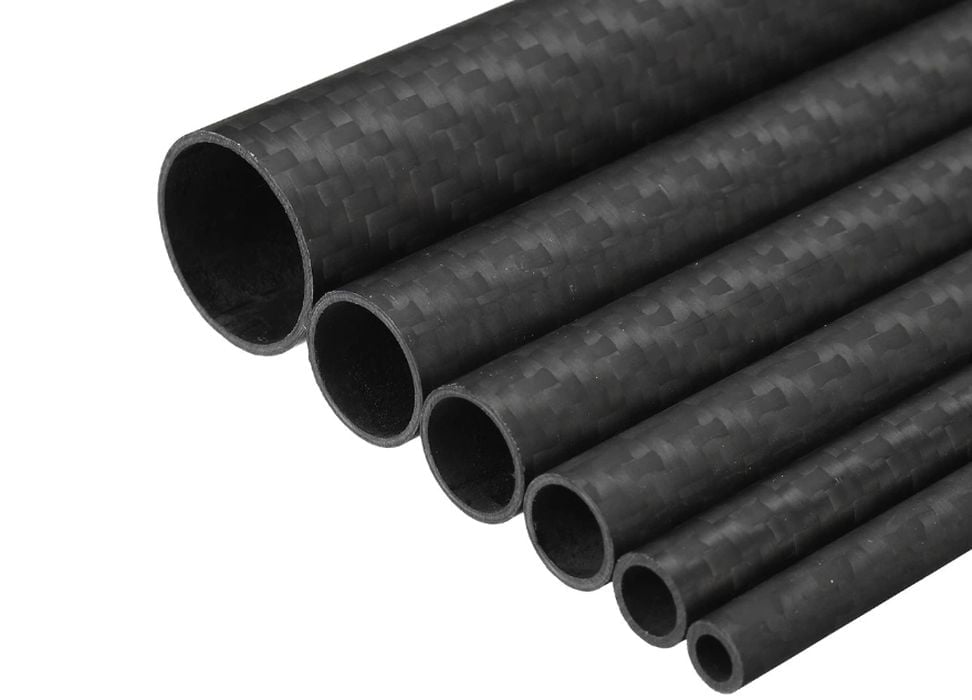
We’ve all heard about 3D printers printing with carbon fiber, but what about a 3D printer MADE FROM carbon fiber?
Where did this idea come from? We were approached (mistakenly) by an overseas manufacturer that believed we were a 3D printer manufacturer. This confusion occurs constantly for some unknown reason, but we’re happy to be contacted by anyone in the industry.
Anyhow, the supplier proposed using their carbon fiber tubes for building 3D printers instead of the usual aluminum extrusions.
Could this be a good idea? I don’t believe I see any desktop 3D printers using this approach. Virtually all desktop 3D printers use standard aluminum extrusions for their frame components.
The earliest desktop 3D printers used wood or acrylic as their frame, which wasn’t particularly rigid. As a result, 3D prints produced on those devices were quite wobbly. But poor frame stability was only one of the issues with those devices.
Later, manufacturers shifted to aluminum extrusions, which are pretty rigid, assuming they are sufficiently thick. Early attempts with aluminum extrusions often used very thin extrusions, which really weren’t that stable.
Recently we’ve been seeing quite rigid implementations that have used thicker aluminum extrusions with CNC-milled attachment points. These have resulted in quite rigid frames that contribute to print quality.
Carbon fiber tubes are now a common building component, and can have a round, square, hexagonal or other profile. They are essentially sheets of carbon fiber that are rolled up into tube form and fixed with a binder. It would be like making a tube with fiberglass.
These carbon fiber tubes are used in applications requiring lightweight but strong materials, and a very good application would be drone construction. Those devices require both strength and low weight, and these carbon fiber tubes would definitely deliver those properties.
So would there be any benefit in building the frame from carbon fiber tubes? Let’s do some speculation.
Carbon fiber is an extraordinarily rigid material that is very lightweight, and resistant to many environmental effects. Tubes can be 4-5X stiffer than aluminum. It can also be conductive.
If you were to build a 3D printer with carbon fiber it could be extremely rigid if done with a proper design. While the tubes themselves are rigid, the design would have to ensure they are attached in a manner that doesn’t allow twisting or bending. The weak point would be the joints, but that could be overcome with proper design.
The resulting frame would be quite lightweight, but for operational purposes that provides no advantage for a 3D printer. They sit on a table, mostly and might occasionally be moved around. Where this may be beneficial is during the shipping phase, where a lightweight printer might be less expensive to ship.
There would also be no advantage to carbon fiber’s environmental resistance properties, as the devices don’t get exposed to such conditions.
So it would seem the only advantage is the extreme rigidity, which could be somewhat beneficial. However, today’s aluminum extrusions do a pretty good job already.
Another factor is cost. Would the carbon fiber tubes cost less to use? I poked around and found one could purchase 2m lengths of 6mm diameter carbon fiber tubes for US$60-150, which would be more than enough to build at least one machine.
On the other hand, pricing I found for standard aluminum extrusions was less expensive, at around US$25 for the same length.
But these are apples and oranges: you would need far slimmer carbon fiber tubes than aluminum extrusions, so maybe there is a cost benefit? Also when building a series of machines, the manufacturer would be purchasing in bulk, lowering the unit price considerably.
There is a possibility that by using slim but strong carbon fiber tubes, the parts cost might be less than thicker aluminum extrusions. By doing so, the manufacturer would also save on shipping. This all depends on sourcing the parts from an economical supplier.
I don’t know if any desktop 3D printer manufacturers are looking into this possibility, but if they do, they could boast of higher quality prints due to the increased rigidity.
